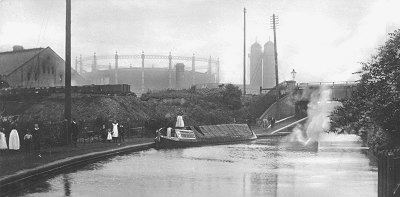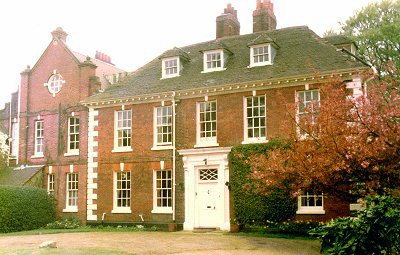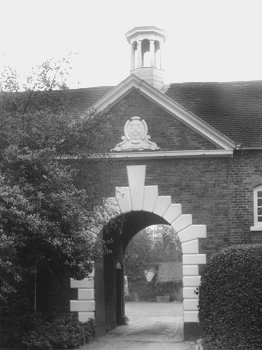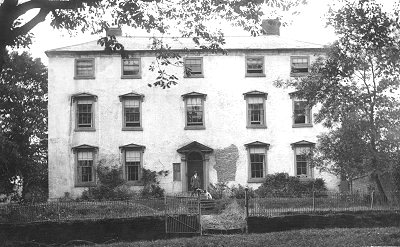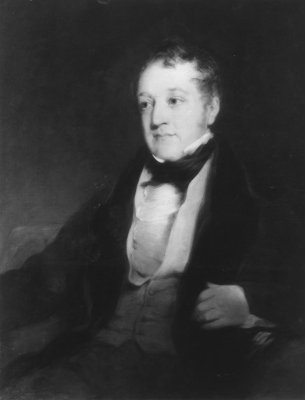BUSHBURY IN THE EIGHTEENTH CENTURYThe coming of industry In the first few years of the century to the south and east of Bushbury a trace of smoke was appearing in the sky as the small cottage industries of nail, chain and lock making expanded and the first steam engines started to drain the pits and allow deeper working for coal. As the century progressed more and more people would gain a larger proportion of their livelihood from the metalworking and coal mining industries, although in Bushbury the proportion of income from industry was small in comparison to parishes to the south and east. No doubt many young men left Bushbury to seek a better living in the industrial parishes of what was to become in the next century the "Black Country". No records exist for the parish as a whole, but in the Catholic community one householder, Richard Smith, is listed as a locksmith among nearly twenty engaged in rural occupations in 1705 and 1706. The proportion would probably have been similar among the rest of the community, although it is unlikely that many labouring families existed solely on income from either industry or agriculture alone. No doubt Richard Smith had a pig and a few chickens, and the agricultural labourers were adept at nail making or filing a few locks to eke out a living in the hard winter months. In the late 1720s the epidemic which afflicted many parts of England probably affected Bushbury. We do not know what the illness was, possibly influenza or even some sort of plague. The Bishop's Transcripts of the Parish Register for that period are missing and, following the fire at the Vicarage, we do not know even if the Parish Register was kept at this time. The vicar, Thomas Hall made his last entry on June 29th 1726, and the Transcripts recommence in July 1730 with the new vicar Seth Shepperd. Perhaps Thomas Hall was one of the victims.
New roads The development of industry was felt in many ways. The old road system was proving totally inadequate for the transport of the products of the expanding industries of iron in the south of the county, and pottery in the north. By 1747 a "Petition of the Gentlemen, Freeholders, Tradesmen and other Inhabitants of Wolverhampton" was presented to the House of Commons complaining about the state of the roads, including that from "The Town of Stafford, to and through the same town of Wolverhampton and to a place called Seven Stars in the parish of Kingswinford." A further petition followed in 1760, and by 1770 the new turnpike, "from Green Gate on the south side of Stafford, through the towns of Dunstan and Penkridge to a road called Streetway (i.e. Watling Street) in the road to Wolverhampton, and from the road called Streetway through the town of Wolverhampton" was constructed. Not all of this road was cut across the fields and commons; some was made by the improvement of existing routes. We know for instance that the road up Oxley Bank was in existence in 1649, as it appears in William Fowler's map of Sir Richard Leveson's Oxley Farm. There were toll gates at the end of North Road, at the foot of Oxley Bank and at the "Three Tuns." Similarly, on the eastern side of the parish, a new turnpike from Wolverhampton to Cannock was being built "from Stafford Street, and the Four Ashes (marked on Isaac Taylor's map of 1750) and by a brook called Cranmore Brook, in the road to Cannock, to Hilton, and from thence to the end of the road towards Shareshill, which joins the road leading from Shareshill aforesaid to Essington Wood". Parts of this new road are still identifiable, the section from the old Henry Meadows factory entrance to the "Golden Lion", and at Westcroft, where a short piece of new road links two arms from an older crossroads. (Map Reference 939026). The maintenance of roads in and around the parish is mentioned in the P.T.Hinckes papers in the Foxley Collection at Hereford Record Office. From 1791 until 1819 he lists sales of gravel from Bushbury Hill for use on the Stafford Turnpike and in Wednesfield, (presumably on the Cannock Road). Until 1801 the price was a penny a load, when it rose to twopence. In 1814 he supplied the needs of Bushbury parish for two guineas, but then gave half the sum to Mr. Wightwick for collecting it. Hundreds of loads were removed in this relatively short period; little wonder that the southern slopes of Bushbury Hill had disappeared by our time and were only replaced by the tipping of municipal refuse in the 1940s and 50s. T.H.F.Whitgreave also mentions road repairs in his diary:- June 18th 1804, "Sent two teams to the Highways, Mr. Partridge sent one, Mrs. Horton sent one man, Francis Warillow Himself." New canals But new roads were not the only change in the Bushbury landscape in the 1760s. On the western edge of the parish the Staffordshire and Worcestershire Canal was constructed to link the Trent and Mersey Canal at Great Heywood with the River Severn at Stourport. A distinctive section of the original construction can be seen at "The Narrows" in Fordhouses, near Forster Bridge in Wobaston Lane. Here, the canal engineer James Brindley reduced the width of the canal to save expense in cutting through the outcrop of sandstone. This is one of the few places in the whole length of the canal where two narrow-boats cannot pass. The Birmingham Canal, authorised in 1768, was completed by 1772 and crossed the Stafford Road at Gorsebrook, joining the Staffordshire and Worcestershire at Aldersley Junction, where stables, warehouses etc. were set up.
New houses and new enclosures
Low Hill House was built about 1760, and about the same time Samuel Swinfen rebuilt Oxley Manor. Gorsebrook House dated from about the same time if not earlier. It seems unlikely that such a house would have been built after the new turnpike had been constructed alongside it and the Birmingham Canal cut so near. New Oxley House, standing near the junction of Church Road and Stafford Road is in the style of the second half of the eighteenth century, and Bushbury Hill Farm was also from the 1780s. The process of piecemeal enclosure seems to have been continued by the land owning gentry, with or without formal approval. The Bushbury Manor papers contain a few references. "The north side of Wollery Green inclosed about the year 1776 or 1777 by the late Mr. W. Huskisson, and on the south side by Mr. T. Millen the tenant of Seawall Farm in the year 1797. The whole of the Green was about one acre and a half." And " a small bit of land where the windmill formerly stood on Coven Heath inclosed about six or seven years since by James Hordem Esq." Further evidence of early encroachment on Coven Heath is also recorded, "For a cottage (erected 1795) on the south side of Coven Heath within the manor of Bushbury with near half an acre of land adjoining the same, bounded east and west by Coven Heath, north by small gardens, and south by land of late Mansfield. James Smith (on lease for 40 years from Michaelmas 1790 at p.ann. £0-3-0." There are still one or two very small cottages on the edge of the heath, brick structures probably replacing earlier less substantial houses. "Deodands" The Oxford English Dictionary defines "Deodand" as: "A thing forfeited or to be given to God. A personal chattel, which having been the immediate occasion of the death of a human being, was given to God as an expiatory offering, i.e. forfeited to the Crown to be applied to pious uses, e.g. to be distributed in alms" (Abolished in 1846.) The Bushbury Manor Papers contain two interesting examples of the practice of "Deodand", from about this time:
The lives of the poor Beside the coming of the turnpike roads and the canals in the eighteenth century, another improvement in the life of the parish was the Workhouse. We do not know when it was built, but it stood at Fordhouses at the junction of Wobaston Lane and Stafford Road. Some cottages known as the "Workhouse Cottages" survived until this century, but the workhouse probably closed early in the nineteenth century. (Among a collection of papers sent to the Rector of Bushbury in 1982 from the Moreton family is a written addition to a printed list of Bushbury Charities, "Purchased by A.Hordern 1831 for £400 for the new Poor House now called the Dole House." This fixes the date of the construction of the Dole House which still stands at the east end of Bee Lane. It presumably replaced the old Workhouse.) We have no records of Bushbury Workhouse but records of Wolverhampton Workhouse give some indication of the plight of the poor in Bushbury. Beside the poor living in Wolverhampton workhouse, "Outpay" was made to those who had some sort of roof over their heads but were otherwise destitute. From Wolverhampton in 1795 the following Bushbury residents received relief: Collins family, Fordhouses 2s-Od per week. Mary Bridgen Bushbury 9d per week. Widow Titley Oxley Is-Od per week. Albutts family Bushbury Is-6d per week. with two children 6 and 4 years. Bushbury Parish spent £103-3s-5d on Poor Relief for the year ending Easter 1776, £ll2-4s average for the years ending Easter 1783/4 and 5 and by 1803 the figure had risen to £236-1s-ld. In that year seventy people from the parish were receiving relief in any "House of Industry" or "Workhouse" and three hundred and fifty were receiving "Outside Relief." If life for the poor and destitute was hard, it does not seem to have been much better for those able to work. A particularly vivid picture of life of the working poor is given in A.C. Pratt's Black Country Methodism (1891).
William Webb survived and in later life became an Elder of the "Noah's Ark" chapel in Wolverhampton. Coal - and another new canal At the Eastern end of the parish in Essington manor, coal mining had been established since at least the early years of the century. The neighbouring "New Invention" had possibly been a steam engine used to drain a pit. Shaw refers to the Wyrley and Essington Canal (proposed 1792) going through "the very extensive mines of coal", "the property of the Marquis of Stafford, Mr. Pulteney, Mr. Anson and Mr. Vernon who has a new colliery at Essington Wood". The Wolverhampton banker James Hordern took a prominent part in financing the new canal. The western arm of the new canal, serving the Essington area was opened by 1795. There was a temporary setback in the summer of 1798 when the Sneyd reservoir, on the southern edge of Essington manor burst its banks and caused much damage," the water swept everything before it in the line it took through Shenstone, Hopwas, Drayton etc. till it fell into and overflowed the Tame at Tamworth". The main line of the canal was opened in the early years of the new century and Essington coal moved easily and economically into industrial South Staffordshire and Birmingham. The ownership of Oxley Manor in the eighteenth century In the Sixteenth century Oxley Manor had belonged to the Leveson Family of Trentham Hall but in 1655 it was given to John Langley, a steward of the Levesons. It remained in that family until 1752 when the following notice appeared in the Birmingham newspaper "Aris' Gazette":
The buyer was Samuel Swinfen, who in 1749 had changed his tame from Grundy in order to inherit the estate of his uncle, (also Samuel). The nephew, of Swinfen near Lichfield, with his inheritance purchased several Staffordshire estates besides Oxley, and although he never lived at Oxley he rebuilt the old sixteenth century house for his sister Dorothy. She was the first wife of William Huskisson who bought Bushbury Manor in 1774 from Elizabeth, widow of Richard Cavendish (Chandler). Samuel Swinfen died in 1770, and entailed Oxley to the two sons of William and Dorothy Huskisson, Samuel and William. William the elder died in 1781, his son Samuel had died in 1776, so both manors passed to the younger son William. He had been born in 1743, and on March 12th 1769 married Elizabeth Rotton at Bushbury Church. (The Rotton family had lived in the parish for several generations). They had four sons, William (born March l lth 1770), Richard, (born May 1771), Samuel, (born March 1773), and Charles (born August 1774).
All this however was in the future. He was twenty years of age when his father died in 1790, and under the terns of the will Bushbury Manor was to be sold by auction. It was bought by Peter Tichborne Hinkes of Tettenhall Wood. Three years later, Huskisson the rising young politician sold Oxley Manor to raise funds to continue his career. It was bought by James Hordern the Wolverhampton banker. Richard Huskisson had trained as a naval surgeon, and was appointed to the frigate "Thetis" in 1793. In the next year following action at Martinique, St. Lucia and Guadaloupe, he died aged twenty three. William wrote to his friend the poet William Rayley, "I am deprived of the companion of my infancy, of my education and of almost every hour of my existence." The memorial to Richard (and their parents) in the chancel of Bushbury church bears a verse to his memory by William Hayley:-
Samuel Huskisson, a Major General, died in 1854, and Charles, who had lived the life of a country gentleman, died in 1857 at Hazelwell Hall in Worcestershire. Thomas Huskisson, a half-brother of the above was born on July 31st 1784. A pupil at Wolverhampton Grammar School, he entered the Navy in July 1800 and was at Trafalgar in H.M.S.Defence. A Captain of Greenwich Hospital, he died on December 21st 1844.
The ownership of Bushbury Manor in the eighteenth century In 1721 Archibald Grosvenor and his wife Frances, (nee Hale), were childless and the last of their family. His elder brother Jonas had died unmarried in 1705, and his sisters Elizabeth, Sarah and Henrietta were all without issue. Likewise the children of his father's second marriage, John, Sherington, Richard, Talbot, Charles and Catherine were either dead or childless. Bushbury Manor was therefore sold after being in the possession of the Grosvenors for nearly two hundred years. It was bought by Edward Chandler, Bishop of Lichfield since 1717. Bushbury was only one of many properties he owned in various parts of the country, and except for the name of his steward, Blest Colclough, we know very little about his relations with his tenants. In 1730 Edward Chandler was translated to the Bishopric of Durham. His wife was Barbara, eldest daughter of Sir Humphrey Briggs, and there were two sons and three daughters of the marriage. The eldest son Richard, married Elizabeth daughter of Sir James Cavendish of Staveley Park, Derbyshire, (a member of the notable Whig family and brother of the Duke of Devonshire). Richard Chandler's sister Barbara married William, brother of Elizabeth Cavendish. Bishop Edward Chandler died on July 20th 1750, and in the following year both Sir James Cavendish and his son William died. Richard Chandler therefore changed his name to Cavendish and inherited their estate. He was Solicitor of the Excise, a Commissioner of the Customs and Member of Parliament for Wendover. Following his death in 1769 his wife sold Bushbury Manor to William Huskisson of Oxley Manor in 1774. The Huskissons moved to Oxley in 1776. William lived until 1781, but following the death of his son, (also William) in 1790, his grandson advertised the manor for sale in the Wolverhampton Chronicle of August 4th.
The buyer was Peter Tichborne Hinckes of Tettenhall Wood. |
